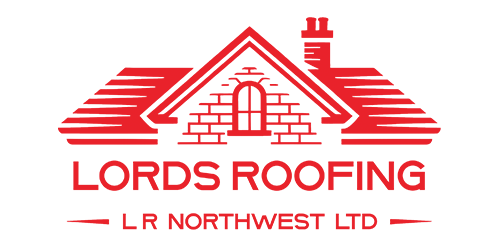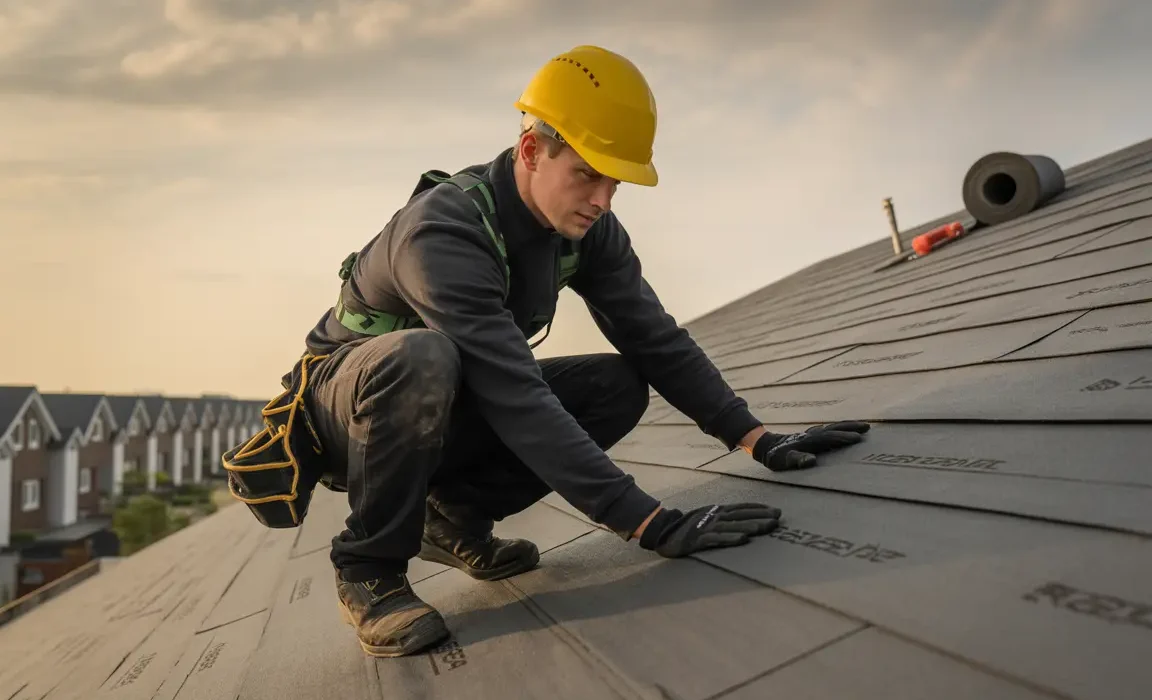Identifying and Repairing Damaged Roof Felt (Underlayment): Crucial for Keeping Manchester Homes Dry
Your roof is a complex system, with multiple layers working together to protect your home from the elements. While tiles or slates are the visible shield, there’s a crucial, often unseen layer beneath them: the roof felt, also known as underlayment. This secondary barrier plays a vital role in preventing moisture ingress, especially in a climate like Manchester’s, where rain and wind are frequent visitors. Ignoring damage to the roof felt can lead to significant problems down the line. At Lords Roofing, with over 40 years of experience keeping Manchester properties watertight, we understand the critical importance of this layer.
What is Roof Felt/Underlayment and Why is it Important?
Think of the roof felt as your roof’s backup defence system. While your primary roofing material (tiles, slates, etc.) handles the bulk of the weather, the underlayment provides an essential secondary layer of protection. Its main functions include:
- Preventing Water Penetration: It catches any water that might get past the primary roofing layer due to wind-driven rain, snowmelt, or broken/missing tiles.
- Protecting the Roof Deck: It helps keep the wooden roof deck (the boards or sheeting beneath the felt) dry, preventing rot, mould, and structural damage.
- Managing Moisture: Some modern breathable underlayments also allow moisture vapour from inside the building to escape, helping to prevent condensation issues in the loft space.
- Providing a Temporary Barrier: During roof installation or repair, the underlayment offers temporary weather protection until the primary roofing is in place.
Historically, roof felt was made from bitumen-impregnated organic or glass fibre materials. Modern underlayments often use synthetic polymers, offering greater durability, tear resistance, and sometimes, breathability.
Signs Your Roof Felt Might Be Damaged
Since the underlayment is hidden beneath your tiles or slates, identifying damage can be challenging. However, there are several key indicators that suggest your roof felt may be compromised:
- Water Stains or Dampness in the Loft: This is often the most obvious sign. Look for discolouration, damp patches, or active drips on the underside of the roof deck, rafters, or stored items in your loft. These indicate water is getting past the primary roofing and the underlayment isn’t stopping it.
- Sagging or Drooping Between Rafters: When viewing the underside of your roof from the loft, the underlayment should ideally be relatively taut (though some deliberate drape is sometimes included during installation). If you see noticeable sagging or bellies between the rafters, the felt may have stretched, torn, or come loose from its fixings, creating pockets where water can pool.
- Visible Tears, Holes, or Deterioration: If you have safe access to your loft, carefully inspect the underlayment surface (do not step directly onto it if it’s sagging). Look for visible tears, punctures, or areas where the material appears brittle, cracked, or is disintegrating. This is more common with older, traditional felt.
- Signs of Pest or Animal Damage: Birds, squirrels, or rodents can sometimes damage underlayment in the loft, creating holes for entry or nesting material. Look for nests or chewed areas near the eaves or other potential entry points.
- Damaged Primary Roofing: While not a direct sign of felt damage, frequently missing, cracked, or slipped tiles/slates mean the underlayment is being exposed to more water than it’s designed to handle, increasing the likelihood of its failure over time. Deterioration of felt might also be visible from the exterior if primary roofing is lifted or missing.
What Happens When Roof Felt Fails?
Ignoring damaged roof felt can lead to a cascade of problems that are far more expensive and disruptive to fix than addressing the underlayment itself:
- Water Leaks: The primary consequence is water finding its way into your loft, ceilings, walls, and potentially down into lower levels of your home.
- Damage to the Roof Deck: Persistent moisture exposure will cause the timber roof deck to rot, weaken, and potentially require costly replacement.
- Compromised Insulation: Wet insulation loses its thermal properties, leading to increased energy bills and a less comfortable home. It can also become a breeding ground for mould.
- Mould and Mildew Growth: Excess moisture in the loft creates an environment ripe for mould and mildew, impacting air quality and potentially causing health issues.
- Damage to Interior Finishes: Water leaks can cause staining, blistering paint, sagging plasterboard, and other significant damage to your home’s interior.
- Potential Structural Issues: In severe cases, prolonged water ingress and timber rot can compromise the structural integrity of the roof.

Causes of Underlayment Damage
Underlayment can be damaged by several factors over its lifespan:
- Age and Deterioration: Traditional felt has a limited lifespan (often 20-30 years) before it becomes brittle and loses its protective qualities. Synthetic underlayments generally last longer but aren’t immune to age.
- Poor Installation: If the underlayment was installed incorrectly, without proper overlap, sealing, or securement, it can be prone to tearing or detachment.
- Physical Damage: Walking on the roof, carrying out other repairs (like chimney work), or even falling debris can accidentally tear or puncture the underlayment.
- Pest Activity: As mentioned, birds or rodents can cause damage, particularly near eaves or fascia.
- Inadequate Ventilation: Excessive heat buildup in a poorly ventilated loft can degrade some types of underlayment over time.
Repairing or Replacing Damaged Underlayment
Repairing damaged roof felt is rarely a simple patch job accessible from the loft. Because the underlayment sits beneath the primary roofing material, effectively addressing damage almost always requires removing the tiles, slates, or other roofing material in the affected area.
The process typically involves:
- Safe Access: Erecting scaffolding or using other safety measures to access the roof area.
- Removing Primary Roofing: Carefully removing the tiles or slates covering the damaged felt section.
- Assessing Extent of Damage: Inspecting the underlayment and the underlying roof deck for the full extent of the problem, including any rot or mould.
- Repair or Replacement: Cutting out the damaged section of underlayment and replacing it with a new piece, ensuring proper overlap and sealing to integrate it with the existing felt. In cases of widespread deterioration, a full roof re-felt may be necessary, which often occurs during a full roof replacement.
- Repairing Roof Deck (If Necessary): Replacing any rotten or damaged timber on the roof deck.
- Reinstalling Primary Roofing: Laying the tiles or slates back correctly, ensuring they are securely fixed and the roof is watertight.
This process requires specialist knowledge, tools, and adherence to safety regulations. It is not a recommended DIY task.
When to Call a Professional Roofer in Manchester
Given the complexity and risks involved, dealing with damaged roof felt is a job best left to experienced professionals. You should contact a trusted roofer like Lords Roofing immediately if you:
- Notice any signs of water ingress or dampness in your loft.
- See significant sagging or visible damage to the underlayment from your loft.
- Are planning any work that requires removing sections of your primary roofing.
- Have an older roof (20+ years) and are concerned about the condition of the felt.
Lords Roofing has the expertise, equipment, and understanding of Manchester’s roofing needs to accurately diagnose underlayment issues and carry out effective, long-lasting repairs or replacements safely and efficiently.
Prevention is Key
While underlayment provides a valuable backup, its lifespan is significantly extended when the primary roofing material is well-maintained. Regular roof inspections (ideally annually or after severe weather) can help identify missing or damaged tiles/slates early, preventing excessive water exposure to the felt below.
Conclusion
The roof felt or underlayment is an unsung hero of your roofing system, providing essential protection against moisture. Ignoring signs of damage can lead to serious and costly problems for your Manchester home. By understanding the role of this layer, knowing what signs to look for, and enlisting the help of experienced local professionals like Lords Roofing when issues arise, you can ensure your roof remains watertight and your home stays dry and protected for years to come.


